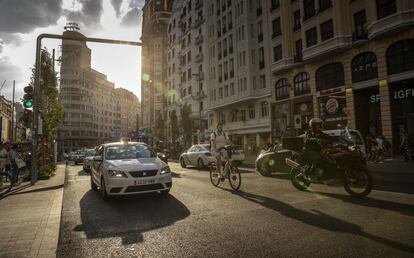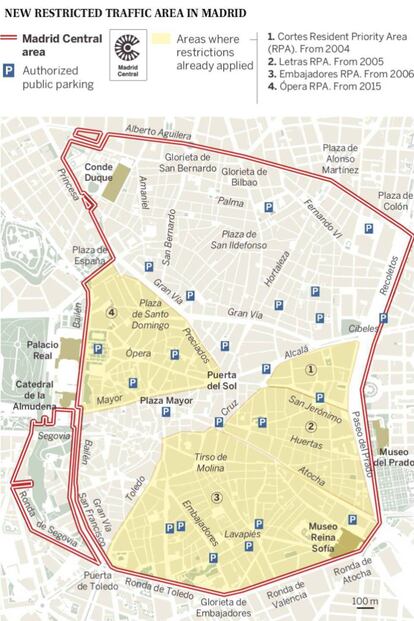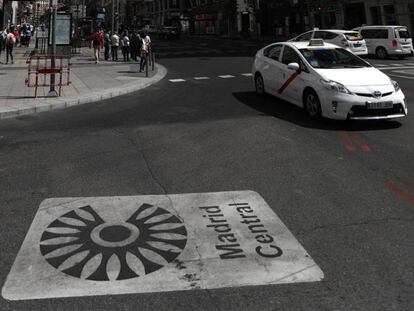Madrid Central scheme sees city pollution fall to 10-year low
Nitrogen dioxide in the Spanish capital dropped to its lowest levels in a decade thanks to the traffic-restricted area, according to a new report from Ecologists in Action


The low-emissions zone Madrid Central produced a significant drop in nitrogen dioxide pollution at 22 of the 24 air-quality monitoring stations in Madrid against the average of the previous nine years, according to a report presented last week by the environmental group Ecologists in Action.
Madrid has failed to meet the European Union’s limit on nitrogen dioxide emissions since 2010. What’s more, the Spanish capital was threatened with EU sanctions for breaching these norms.
Madrid City Hall continues to deny the effectiveness of the low-emissions zone
The new report argues that the drop in nitrogen dioxide emissions is due to the “ripple effect” of the restricted-traffic zone, given that last year’s weather conditions, which are also a factor in pollution, would have increased emissions in the city.
But despite the data, Madrid City Hall, which is governed by the conservative Popular Party (PP) and center-right Ciudadanos (Citizens), with the support of far-right Vox, continues to deny the effectiveness of Madrid Central and is working to ease restrictions in the low-emissions zone to allow more polluting vehicles to drive through the city center, and to reduce the area that is off-limits to traffic.
In June 2019, Madrid Mayor José Luis Martínez-Almeida, of the PP, suspended fines on cars that entered the low-emissions zone without the proper permissions. This decision was later overturned by the courts in response to a lawsuit filed by a body known as Platform in Defense of Madrid Central, which is made up of more than 80 organizations, including Ecologists in Action and Greenpeace.
“The evidence is that Madrid Central works and reduces pollution,” said Ecologists in Action spokesperson Pablo Segura. “That is why we consider it necessary to expand it, applying some of its measures to the rest of the city.”

In 2019, only two air-quality control stations in Madrid breached the legal limit of 40 micrograms of nitrogen dioxide per cubic meter (µg/m3) as an annual average: Plaza Elíptica and Escuelas de Aguirre. Between 2010 and 2018, the number of stations that violated the limit ranged between 18 in 2010 and six in 2014, with an average off 11 stations per year failing to keep within the limit.
“Madrid continued to violate the legislation on nitrogen dioxide, but in far fewer stations than has been the case in the past,” said Juan Bárcena, the head of air quality for Ecologists in Action.
Nitrogen dioxide emissions in Madrid fell 10% on the average from the last decade
“If we look at the map of the stations, Madrid Central is the epicenter of the drop in pollution, and there is also a significant reduction in the stations surrounding the area,” added Bárcena. “On the other hand, stations monitoring outlying areas, such as El Pardo, Villaverde and Barajas, have seen a far less significant reduction. The data clearly shows that there is been no ‘border effect,’ as claimed by the PP and Ciudadanos, but instead a ‘ripple effect’ with positive repercussions throughout the city,” he added, in reference to the argument that the low-emissions zone would increase pollution around its perimeter.
Levels of nitrogen dioxide in Madrid fell 10% on the average from the last decade, and 22% in the Plaza del Carmen air-monitoring station, the only one located within the Madrid Central low-emission zone. For months, the station recorded readings below the annual nitrogen dioxide limit, and for six months it had the lowest readings since records began in 2010.
According to Segura, the fall in pollution was achieved “despite the erratic policy of the new city council aimed at promoting car use, extending the use of polluting vehicles and allowing more cars into the center.”
Madrid Central was introduced by the former leftist administration of Mayor Manuela Carmena at the end of 2018. The pioneering initiative made 472 hectares of the city center off-limits to traffic, except for local residents and public transportation.
But according to Ecologists in Action, Madrid’s new City Hall is undermining the effectiveness of Carmena’s original plan. After Almeida suspended fines on vehicles that violated the Madrid Central zone, nitrogen dioxide emissions jumped by 50% at the Plaza del Carmen station, which had recorded its best data to date between March and June. This rise was not seen in other air-monitoring stations.
“The municipal government’s team denies that Madrid Central works by manipulating the data. They green-washed themselves at the [United Nations] Climate Summit while getting rid of bike lanes and reducing the perimeter of the low-emission zone, which we believe is illegal. That is why we have now taken the matter to the administrative bench [of the Supreme Court],” added Segura.
When you ask people to leave their car at home, you cannot do a U-turn
Ecologists in Action spokesperson Pablo Segura
“Moreover, Almeida and [Madrid deputy mayor Begoña] Villacís presented the plan Madrid 360 as if the proposal had already been approved – when it is just an ineffective, unapproved measure – thereby generating a tremendous amount of confusion among the citizens who do not know which measures apply and which don’t,” said Segura. “There is a lot at stake with these policies, that should be consistent and long term. When you ask people to leave their car at home, you cannot do a U-turn.”
However, Madrid City Council is still entrenched in climate denial, despite the scientific evidence. Last week, its councilor for environment and mobility, Borja Carabante, repeated the claim that Madrid Central “is ineffective” without providing any data or research to support the assertion.
English version by Heather Galloway.
Tu suscripción se está usando en otro dispositivo
¿Quieres añadir otro usuario a tu suscripción?
Si continúas leyendo en este dispositivo, no se podrá leer en el otro.
FlechaTu suscripción se está usando en otro dispositivo y solo puedes acceder a EL PAÍS desde un dispositivo a la vez.
Si quieres compartir tu cuenta, cambia tu suscripción a la modalidad Premium, así podrás añadir otro usuario. Cada uno accederá con su propia cuenta de email, lo que os permitirá personalizar vuestra experiencia en EL PAÍS.
¿Tienes una suscripción de empresa? Accede aquí para contratar más cuentas.
En el caso de no saber quién está usando tu cuenta, te recomendamos cambiar tu contraseña aquí.
Si decides continuar compartiendo tu cuenta, este mensaje se mostrará en tu dispositivo y en el de la otra persona que está usando tu cuenta de forma indefinida, afectando a tu experiencia de lectura. Puedes consultar aquí los términos y condiciones de la suscripción digital.
More information
Archived In
Últimas noticias
Cubans look to Venezuela fearfully after Trump’s incursion: ‘We could be next’
The operation in Venezuela to capture Maduro threatens to widen the cracks in the MAGA movement
Trump clarifies who is ultimately in charge in Venezuela: ‘Me’
Maduro pleads not guilty before the federal court in New York: ‘I am still the president of Venezuela’
Most viewed
- Alain Aspect, Nobel laureate in physics: ‘Einstein was so smart that he would have had to recognize quantum entanglement’
- Gilles Lipovetsky: ‘If you want to live better and fall in love, take Prozac, don’t look to philosophy’
- Alvin Hellerstein, a 92-year-old judge appointed by Bill Clinton, to preside over Maduro’s trial in New York
- Cuba confirms death of 32 of its citizens in the US attack against Venezuela
- Why oil has been at the center of Venezuela-US conflicts for decades










































